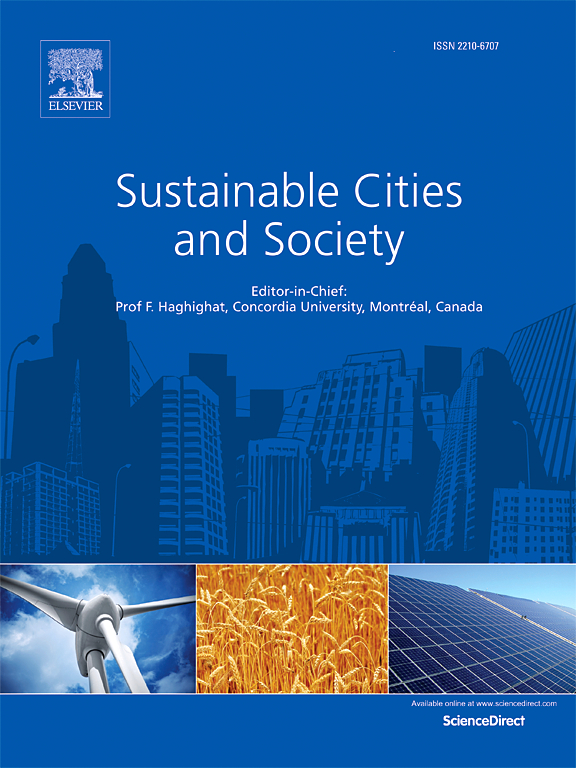Adapting to heatwaves: Optimizing urban green spaces in Beijing to reduce heat health risks
IF 10.5
1区 工程技术
Q1 CONSTRUCTION & BUILDING TECHNOLOGY
引用次数: 0
Abstract
Urban heatwaves pose an escalating threat to public health, particularly for vulnerable populations. Although the optimization of urban green spaces (UGS) is recognized as an effective adaptation strategy, most studies have focused solely on maximizing physical temperature reduction. This study addresses the need for a more holistic approach by integrating heat-related health risk assessments into UGS optimization.
A comparative framework was developed to evaluate the outcomes of temperature-based and risk-based optimization, using a baseline generated under identical spatial and total quantity constraints in central Beijing. Scenario 1 seeks to maximize temperature reduction by prioritizing areas with high cooling efficiency and sufficient greening space. Scenario 2 extends this focus to include high heat exposure and high vulnerability indices, aiming to minimize heat-related health risks. An evolutionary algorithm was employed to solve the spatial optimization problem.
Results indicate minimal differences in temperature reduction between the two scenarios (only 1.93 %), but substantial disparities in heat health risk mitigation, with the risk-based scenario achieving 117.41 % greater risk reduction than the baseline and 70.39 % higher than the temperature-focused scenario. The risk-based approach significantly outperforms the temperature-focused scenario, underscoring the value of prioritizing vulnerable populations in urban green space planning. This indicates that prioritizing vulnerable populations can significantly strengthen urban resilience without substantially compromising cooling performance.
By harmonizing physical cooling benefits with health risk alleviation, the proposed framework promotes a more efficient approach to UGS planning. The findings underscore the importance of integrating social dimensions into climate adaptation strategies, providing insights for policymakers and urban planners seeking to balance environmental efficiency with public health imperatives.
适应热浪:优化北京城市绿地,降低热健康风险
城市热浪对公众健康构成日益严重的威胁,特别是对弱势群体。虽然城市绿地优化被认为是一种有效的适应策略,但大多数研究都只关注最大限度地降低物理温度。本研究通过将与热相关的健康风险评估纳入UGS优化,解决了更全面的方法的需求。以北京市中心为例,在相同的空间和总量约束条件下,建立了基于温度和风险的优化对比框架。方案1寻求通过优先考虑具有高冷却效率和足够绿化空间的区域来最大限度地降低温度。方案2将这一重点扩展到包括高热暴露和高脆弱性指数,旨在最大限度地减少与热有关的健康风险。采用进化算法求解空间优化问题。结果表明,两种情景之间的温度降低差异很小(仅为1.93%),但在热健康风险缓解方面存在巨大差异,基于风险的情景比基线降低了117.41%的风险,比以温度为重点的情景高70.39%。基于风险的方法明显优于以温度为重点的情景,强调了在城市绿地规划中优先考虑弱势群体的价值。这表明,优先考虑弱势群体可以在不显著影响冷却性能的情况下显著增强城市韧性。通过协调物理冷却效益和减轻健康风险,拟议的框架促进了更有效的UGS规划方法。研究结果强调了将社会层面纳入气候适应战略的重要性,为寻求平衡环境效率与公共卫生需求的政策制定者和城市规划者提供了见解。
本文章由计算机程序翻译,如有差异,请以英文原文为准。
求助全文
约1分钟内获得全文
求助全文
来源期刊

Sustainable Cities and Society
Social Sciences-Geography, Planning and Development
CiteScore
22.00
自引率
13.70%
发文量
810
审稿时长
27 days
期刊介绍:
Sustainable Cities and Society (SCS) is an international journal that focuses on fundamental and applied research to promote environmentally sustainable and socially resilient cities. The journal welcomes cross-cutting, multi-disciplinary research in various areas, including:
1. Smart cities and resilient environments;
2. Alternative/clean energy sources, energy distribution, distributed energy generation, and energy demand reduction/management;
3. Monitoring and improving air quality in built environment and cities (e.g., healthy built environment and air quality management);
4. Energy efficient, low/zero carbon, and green buildings/communities;
5. Climate change mitigation and adaptation in urban environments;
6. Green infrastructure and BMPs;
7. Environmental Footprint accounting and management;
8. Urban agriculture and forestry;
9. ICT, smart grid and intelligent infrastructure;
10. Urban design/planning, regulations, legislation, certification, economics, and policy;
11. Social aspects, impacts and resiliency of cities;
12. Behavior monitoring, analysis and change within urban communities;
13. Health monitoring and improvement;
14. Nexus issues related to sustainable cities and societies;
15. Smart city governance;
16. Decision Support Systems for trade-off and uncertainty analysis for improved management of cities and society;
17. Big data, machine learning, and artificial intelligence applications and case studies;
18. Critical infrastructure protection, including security, privacy, forensics, and reliability issues of cyber-physical systems.
19. Water footprint reduction and urban water distribution, harvesting, treatment, reuse and management;
20. Waste reduction and recycling;
21. Wastewater collection, treatment and recycling;
22. Smart, clean and healthy transportation systems and infrastructure;
 求助内容:
求助内容: 应助结果提醒方式:
应助结果提醒方式:


